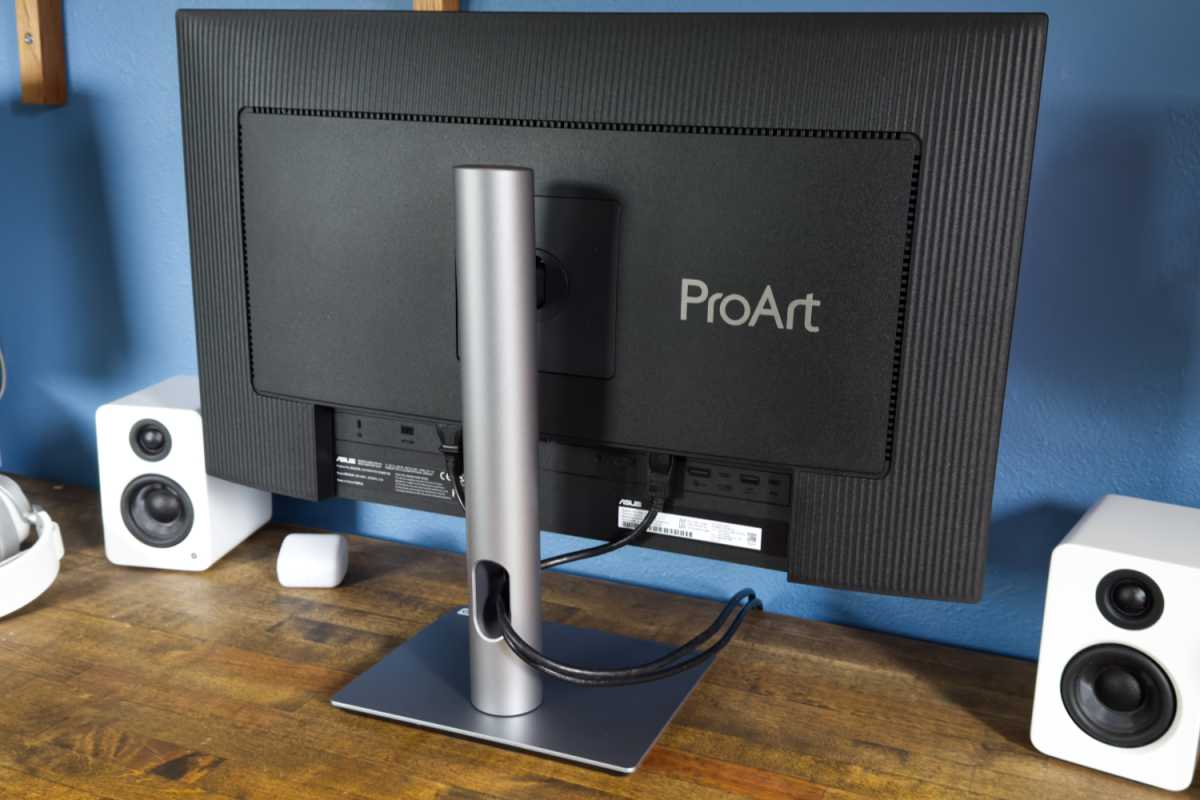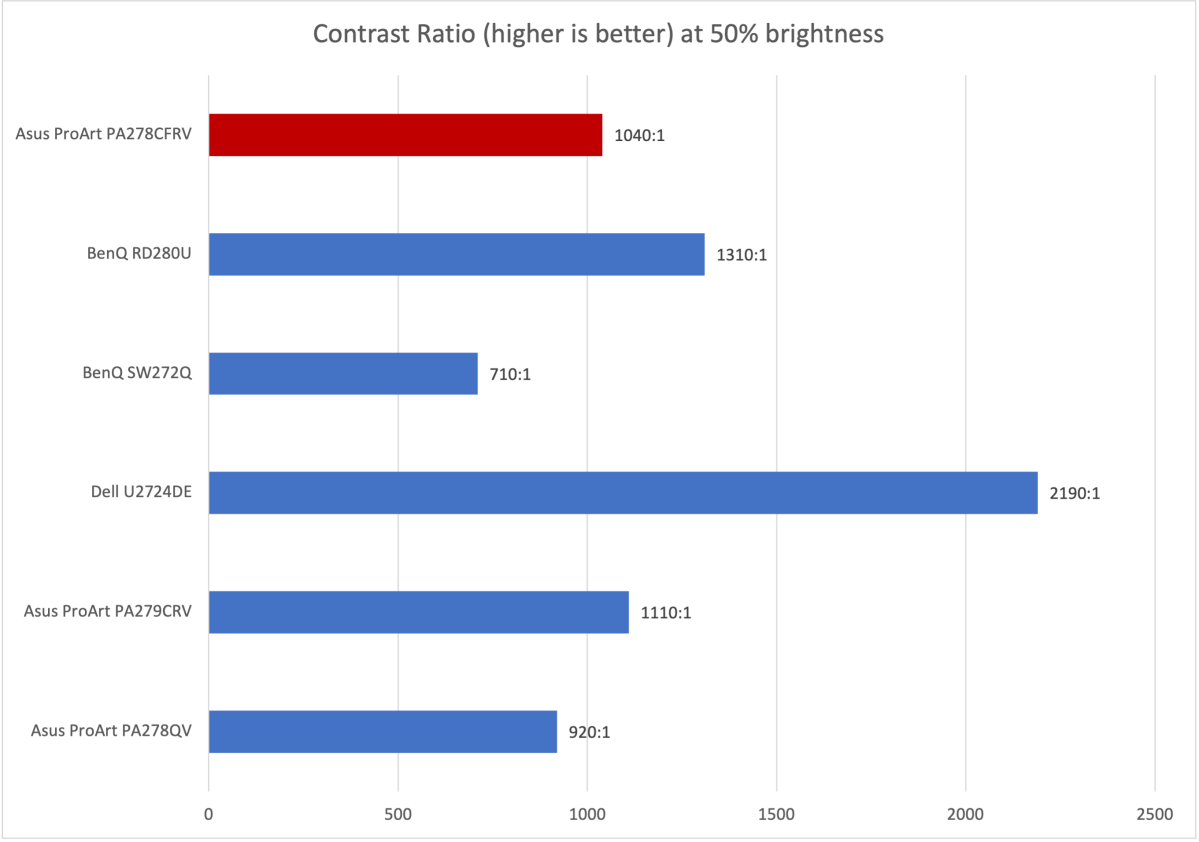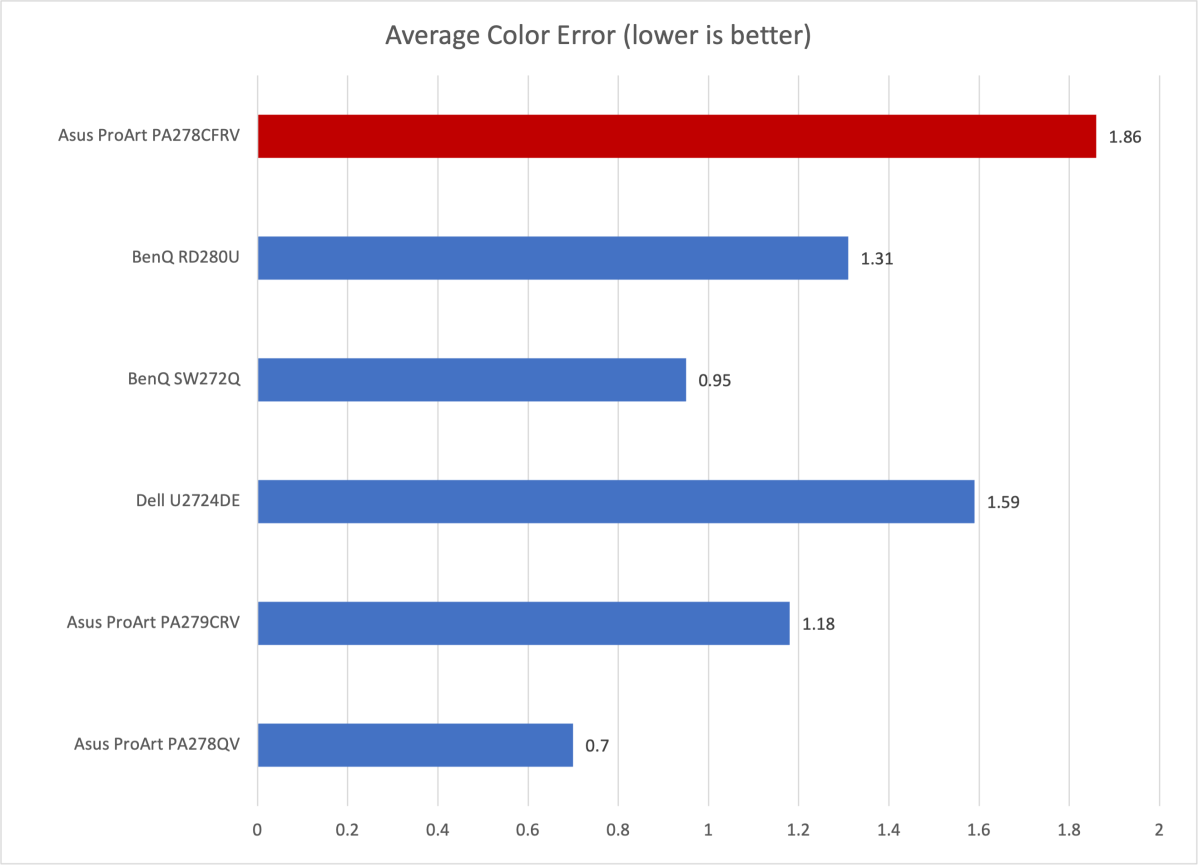
 Image: Foundry
Image: Foundry
At a glance
Pros
USB-C port with 96 watts of Power DeliveryGood color performance and wide color gamutEasy-to-use menus with many optionsUp to 100Hz refresh rate with Adaptive Sync
Cons
Mediocre contrast, brightnessHDR is available but disappointsColor accuracy is good but doesn’t beat peers
Our Verdict
The Asus ProArt PA278CFRV offers the color performance and connectivity required for professional productivity, content creation, and other work.
Price When Reviewed
This value will show the geolocated pricing text for product undefined
Best Pricing Today
Price When Reviewed
$379
Best Prices Today: Asus ProArt PA278CFRV
RetailerPrice $302.95View Deal
$302.95View Deal
The Asus ProArt line includes a wide range of professional content creation and productivity monitors, but its entry-level models often receive the most attention — and for good reason. Past Asus ProArt displays, like the PA278QV and PA279CRV, offered excellent color performance at a very low price. The Asus ProArt PA278CFRV continues this trend, meeting the expectations set by those prior offerings.
Asus ProArt PA278CFRV specs and features
The Asus ProArt PA278CFRV is a 27-inch monitor with a resolution of 2560×1440 and an In-Plane Switching (IPS) display panel. This is typical for a productivity and content creation monitor. The refresh rate stands out, however, as the monitor can handle refresh rates up to 100Hz. That’s not uncommon among general-use and gaming monitors, but among productivity monitors, some competitors are still at 60Hz or 75Hz.
Display size: 27-inch 16:9 widescreenNative resolution: 2560×1440Panel type: IPSRefresh rate: Up to 100HzAdaptive sync: VESA MediaSyncHDR: Yes, VESA DisplayHDR 400 CertifiedPorts: 1x HDMI 2.0, 1x DisplayPort 1.4, 1x DisplayPort 1.4-out (for daisy-chain), 1x USB-C with DisplayPort Alternate Mode and 96 watts Power Delivery, 1x USB-C 3.2 Gen 1 downstream, 3x USB-A 3.2 Gen 1 downstream, 3.5mm audio-outVESA mount: 100x100mmSpeakers: 2x 2-watt speakersPrice: $379 MSRP
Asus’ connectivity also stands out. The monitor has a USB-C port with DisplayPort and up to 96 watts of Power Delivery, which is perfect for powering and charging most laptops. It also has DisplayPort-out, which is handy if you plan to use multiple monitors but your PC only has one video-out port.
The Asus ProArt PA278CFRV is designed for professional use with a focus on productivity and content creation. It features a reserved and subtle design, with the panel clad in charcoal-colored plastics. The stand, meanwhile, has a sleek silver finish.
Further reading: See our roundup of the best home office monitors to learn about competing products.
While the monitor is reserved, Asus does offer a distinctive design language for its ProArt monitors, which includes a heatsink-like ribbing on the back of the panel. This new monitor will complement any recent ProArt gear already on your desk.


Foundry

Foundry
Foundry
Asus offers an ergonomic yet functional monitor stand that adjusts for height, tilt, and swivel, and can also rotate 90 degrees for portrait orientation. While these features are common in office and productivity monitors, it’s still a welcome inclusion, especially considering that this monitor is more affordable than similar models from Dell’s Ultrasharp and BenQ’s photography monitor lines.
The stand is stable and has a small, flat base that doesn’t take up much desk space. Its flat design also allows you to place small items or notebooks on it without issue. If you prefer using a third-party monitor arm, though a 100x100mm VESA mount is available.
Asus ProArt PA278CFRV connectivity and menus
The Asus ProArt PA278CFRV offers a lot of connectivity, which is arguably one of the best reasons to buy the monitor. Its video inputs include one HDMI 2.0 port, one DisplayPort 1.4, and one USB-C with DisplayPort Alternate Mode. All of these inputs can support the monitor’s maximum resolution of 1440p at its maximum refresh rate of 100Hz.
While it would be nice to see a fourth video input, the monitor compensates with DisplayPort-out, which can be used for daisy-chaining to a second display. This is a useful feature if your computer has only one video output or if you want to reduce cable clutter on your desk.
Asus doesn’t pull any punches with the USB-C port. In addition to supporting DisplayPort, it provides up to 96 watts of USB Power Delivery, so it can fully power most laptops that don’t have discrete mobile graphics. The USB-C port also connects to a built-in USB hub, which includes one downstream USB-C port and three downstream USB-A ports. This is a solid range of USB connectivity for a monitor priced under $400. A 3.5mm audio-out jack rounds out the connectivity options.


Foundry

Foundry
Foundry
The monitor has a long list of options that can be accessed through a joystick control on the front bezel of the display. They’re flanked by a series of buttons, which is odd for a modern monitor; most choose to tuck the joystick and buttons out of sight. However, this makes sense for a professional monitor, as I assume people who buy this display are more interested than the average user in changing the options to fit their particular needs. The monitor’s options can also be controlled through DisplayWidget, a software utility available on Windows and Mac.
And there’s a lot of options. The monitor supports a broad range of image quality adjustments, including settings for gamma, color saturation, color temperature, and preset modes for sRGB, DCI-P3, and AdobeRGB, among others. The monitor also includes features specific to visual artists, like a built-in grid that can be used to verify the alignment of images on the screen.
I’m not sure Asus has any advantage over BenQ in this area, and Asus notably lacks the helpful remote some BenQ monitors provide. However, the range of options is stronger than recent Dell Ultrasharp monitors we’ve reviewed.
The Asus ProArt PA278CFRV offers a solid range of USB connectivity for a monitor priced under $400.
As an added bonus, the monitor has a built-in ambient light sensor that will adjust the brightness of the display depending on your environment. I find this to be an extremely helpful feature, especially for home and remote workers who might experience a lot of variance in room lighting throughout the day. A light sensor can ensure that your display is never so bright that it causes unnecessary eye strain.
The monitor also includes a pair of two-watt speakers. While it’s nice to have a source of audio if you don’t have external speakers or headphones available, the speakers are weak and only work for basic needs, like hearing Windows or Mac system sounds or listening to a podcast. With that said, the same is true for Asus’ direct competitors. Professional monitors tend to skimp on speaker quality.
Asus ProArt PA278CFRV SDR image quality
The Asus ProArt PA278CFRV is all about its SDR image quality. While it’s true that there are various reasons why professional artists might work with HDR, SDR is still predominant outside of the most demanding use cases — in which case, a monitor under $400 is probably not the right choice. This monitor is aimed at mainstream general-purpose productivity and content creation, where SDR remains the go-to. So, how does the monitor perform?


Foundry

Foundry
Foundry
We start off with brightness, where the Asus ProArt PA278CFRV delivers an acceptable maximum brightness of 360 nits. That is likely good enough for how the monitor will be used in most environments, as this level of brightness is sufficient even for rooms with some uncontrolled lighting and, for reasons I won’t get into here, it’s best to edit SDR at lower levels of brightness that match the standards of the color gamut you choose.
However, if your office has a lot of bright, sunlit windows or is located in an all-glass corporate tower, you might find the ProArt’s brightness pushed to its limits.


Foundry

Foundry
Foundry
Next up is contrast, where again the ProArt PA278CFRV finds itself in the middle of the pack. It performs better than the older ProArt PA278QV, Asus’ previous affordable 1440p monitor for creative professionals, and also outperforms the BenQ SW272Q. However, a contrast ratio of 1040:1 is not remarkable. By comparison, the Dell U2724DE, which features an IPS Black display panel, can achieve a naturally superior contrast ratio of 2190:1. The Dell is more expensive, though.
Unfortunately, the ProArt PA278CFRV’s contrast ratio is limited by the monitor’s inability to reach appropriately low brightness levels in dark scenes. Because of this, dark scenes can suffer from an unattractive gray-silver cast that detracts from the experience. This issue is most noticeable in entertainment like games and movies, but if you frequently edit dark photos or videos, it could be a problem.
On the other hand, most similar monitors face the same issue. So, while I would prefer a better contrast ratio, it doesn’t put the ProArt PA278CFRV behind its closest competitors. Shoppers looking for class-leading contrast need to consider a more expensive Mini-LED or OLED display, like the MSI MPG 341CQPX.


Foundry

Foundry
Foundry
Asus’ new ProArt PA278CFRV provides a good color gamut, reaching up to 97 percent of DCI-P3 and 87 percent of AdobeRGB. While this isn’t a standout color gamut for a monitor in 2024, it’s still quite good and should be up to the task for professional work within the sRGB and DCI-P3 color gamuts, at least.
When compared to the competition, the Asus trades blows with the Dell U2724DE. It’s similar, with just a percentage difference in DCI-P3 or AdobeRGB. The BenQ SW272Q is superior in AdobeRGB, but slightly inferior in DCI-P3 (note that the results here are for the AdobeRGB mode on the SW272Q, however, in DCI-P3 mode the monitor still measured at 94 percent of that color gamut).
Those who own older entry-level Asus ProArt monitors will find that the ProArt PA278CFRV offers a noticeable improvement over previous models. If you have an older ProArt monitor and are considering an upgrade, you will see a benefit in color performance with the new monitor.


Foundry

Foundry
Foundry
The Asus ProArt PA278CFRV’s color accuracy surprised me because it wasn’t as good as the competitors I used for comparison. It’s important to recognize that this slight color error is still fine for most professional use and is also lower than what Asus has promised (it advertises a color error below 2, which is achieved). However, it’s notable that some other monitors offered better out-of-the-box color accuracy.
Thankfully, the Asus ProArt PA278CFRV performed very well in two other key areas important for accurate imaging: gamma and color temperature. It hit the preferred target gamma curve of 2.2 and offered the ideal color temperature of 6500K at the monitor’s default settings. As a result, the image doesn’t look too dark or too bright, and it avoids appearing too cool or too warm. And, as mentioned, the monitor has many settings to change the gamma and color temperature if you want or need to work with a different gamma or color temperature setting.
Sharpness is adequate. The monitor’s resolution of 2560×1440, spread across the 27-inch panel, results in a pixel density of about 109 pixels per inch. This is sharp enough for most situations, but small fonts in documents and fine details in photographs can appear softer or more aliased compared to a 4K monitor. It’s worth knowing that, at the time of writing, the 4K Asus ProArt PA279CRV is only $30 more expensive than the new ProArt PA278CFRV.
Shoppers should also know that while the ProArt PA278CFRV offers dynamic backlight dimming, it doesn’t have a Mini-LED backlight. Because of that, the dynamic backlight can cause huge, easily noticeable variances in display brightness across the screen. Strangely, the ProArt had this feature enabled by default. That’s odd because these variances in brightness are not good for image accuracy, which is what the ProArt is built to offer. All my testing was conducted with the dynamic backlight turned off, and I recommend that every owner turn it off when they receive the monitor.
On the whole, the Asus ProArt PA278CFRV delivers good image quality comparable to its closest competition. It excels in color performance, offering a wide color gamut and decent, though not above-average, color accuracy. It also scores well in gamma and color temperature. It’s a solid choice for working with documents and editing photos or content in SDR. If you plan to play games or watch movies, though, the contrast ratio may give you pause.
Asus ProArt PA278CFRV HDR image quality
The Asus ProArt PA278CFRV is VESA DisplayHDR 400 certified, but like most mid-range monitors, it’s not great, or even passable, when it comes to HDR content.
This limitation is partially due to the monitor’s contrast ratio. The lack of a Mini-LED backlight or an OLED display panel means that the monitor cannot increase the brightness of bright objects without also increasing the brightness of darker areas on the screen. This, in turn, causes a loss of detail in either the brighter objects or the darker areas when viewing HDR content.
Brightness is low, too. I could only make it sustain a maximum HDR brightness of 329 nits, which is low for a monitor that carries VESA DisplayHDR certification. While I don’t doubt that the certification testing managed to produce the required 400 nits of brightness in certain scenarios, I couldn’t replicate it.
The bottom line is this: Although the monitor can display HDR, it’s not useful as an HDR monitor. I would not recommend it for viewing or editing HDR content.
To be fair, this is also true for other productivity and content-creation monitors in this price range. If you’re looking for excellent color gamut, high color accuracy, and good HDR performance, you’re going to need to spend more on a monitor with a Mini-LED or OLED display.
Asus ProArt PA278CFRV motion performance
I’m happy to see the Asus ProArt PA278CFRV offer a maximum refresh rate of 100Hz. While there are some monitors focused on creativity and content creation that offer a higher refresh rate, like the Dell U2724DE with its 120Hz refresh rate, most monitors in this category stick to 60Hz. That can be disappointing since it results in less fluid motion clarity if you want to play PC games.
The Asus also offers something I haven’t seen on any monitor I’ve reviewed before: VESA MediaSync certification. This is a lower level of adaptive sync certification for monitors that can support a variable refresh rate but don’t reach the 120Hz threshold. Because of this, the monitor unofficially supports both AMD FreeSync and Nvidia G-Sync, and it worked seamlessly with my AMD Radeon RX 7800 XT.
While the monitor’s 100Hz refresh rate is a nice upgrade, gamers shouldn’t get too excited about its gaming performance. Motion fluidity and clarity are certainly improved over 60Hz, but they’re still on the lower end of what’s available in 2024. Fast-moving objects remain visible but can appear blurred, and it can be difficult to make out fine details, like text, on objects that are moving across the screen. So, while I applaud Asus for offering a higher refresh rate and adaptive sync support — features I believe all modern monitors should include — gamers looking for top-tier motion clarity may want to look elsewhere.
Should you buy the Asus ProArt PA278CFRV?
The Asus ProArt PA278CFRV is a good choice for anyone looking to buy a productivity or content creation monitor that offers solid color performance and extensive connectivity at its price point. While it has some drawbacks, particularly with contrast, it performs well in terms of color gamut and offers a wide range of image quality options.
The USB-C port is another perk, as it supports up to 96W of power delivery and connects to multiple downstream USB-A ports. Asus also provides an enhanced refresh rate and adaptive sync support, making the monitor more versatile for users who want a productivity display that can also handle occasional gaming.
Shoppers considering the Asus ProArt PA278CFRV might also look at the Dell U2724DE, which is an upgrade in most respects. It’s about $100 to $150 more expensive, though, so the Asus remains the budget-friendly choice.
Best Prices Today: Asus ProArt PA278CFRV
RetailerPrice $302.95View Deal
$302.95View Deal
Author: Matthew S. Smith
Matthew S. Smith is a freelance technology journalist with 15 years of experience reviewing consumer electronics. In addition to PCWorld, his work can be found on Wired, Ars Technica, Digital Trends, Reviewed, IGN, and Lifewire. Matthew also covers AI and the metaverse for IEEE Spectrum and runs Computer Gaming Yesterday, a YouTube channel devoted to PC gaming history.
Recent stories by Matthew S. Smith:
Best USB-C monitors 2024: These displays have a hidden talentBest 4K monitors 2024: HDR, 144Hz, budget, and best overallGigabyte M27QA ICE review: A monitor built for your cozy gaming den




